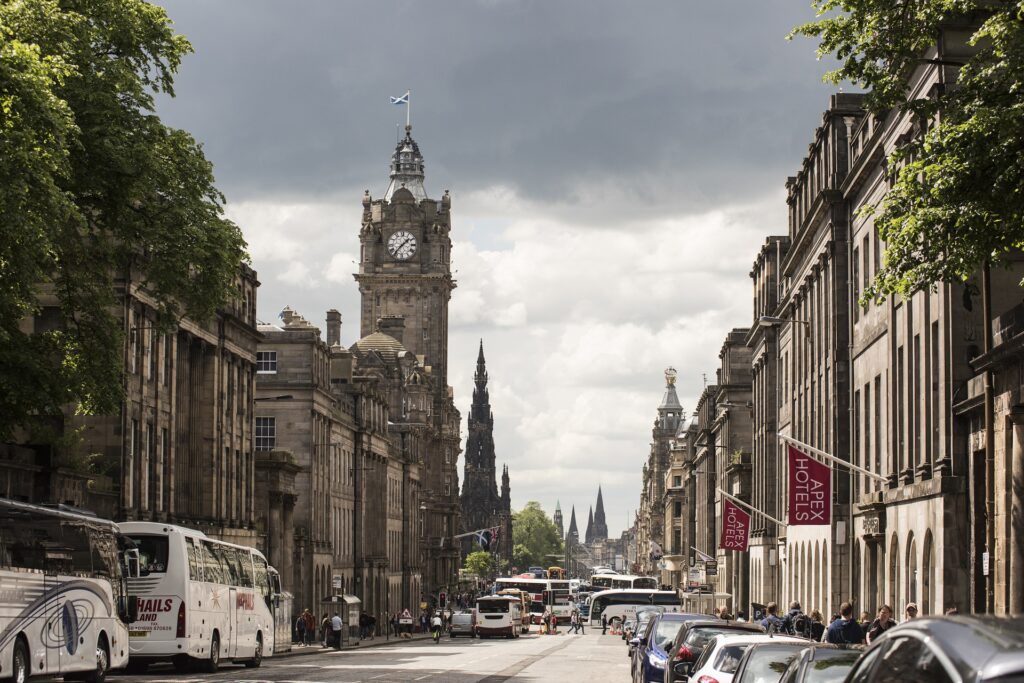FRIENDS of the Earth Scotland have released new data showing how the public are being left at risk by a damning failure by government and local authorities to tackle street air pollution as the campaign group steps up calls for action.
The environmental campaigners described it as a “crisis” that has left thousand of men, women, children, babies and pensioners at risk.
And with 2018 barely weeks old, they are calling for Low Emission Zones being rolled out to included toxic spewing buses and commercial vehicles – something not yet guaranteed.
Glasgow is the first council due to adapt the zones – with its streets the worst performing across the whole of the country.
The city’s Hope Street was today again ranked among Scotland’s dirtiest street – ten years after agreements were put in place for a clean-up.
The campaigners urged Glasgow City Council to ensure that its planned Low Emission Zone restricts the most polluting buses, vans and lorries by the end of this year, and for cars and taxis to be restricted by 2020.
Emilia Hanna, Air Pollution Campaigner for Friends of the Earth Scotland said: “Once again, streets in Scotland have dangerous levels of toxic air pollution which are breaking legal limits.
“The situation across Scotland is potentially showing some slow signs of improvements but filthy streets continue to poison our lungs nearly a decade after a legal deadline.
“Scotland’s first Low Emission Zone will be in Glasgow by the end of this year, and this will be an important test of commitment to address this problem.
“The rest of Scotland is looking to Glasgow to set a high standard with its Low Emission Zone. Glasgow City Council must ensure that its proposed LEZ restricts the most polluting buses, vans and lorries by the end of this year, with cars and taxis restricted by 2020.
“Air pollution from traffic fumes has a devastating impact on health, especially on children and people with existing health problems.
“It is responsible for over 2500 early deaths every year in Scotland and costs the Scottish economy over £1.1 billion annually.
“Air pollution has been linked with heart attacks, strokes, and cancers and can also inhibit children’s lung development.
“It is unacceptable to have continued levels of pollution on our streets that are harming our children’s prospects in life.”
Nitrogen Dioxide Top 6 most polluted streets for Nitrogen Dioxide in 2017: Figures in microgrammes per cubic metre (μg/m3).
Glasgow’s Hope Street – 58
Edinburgh’s St John’s Road – 50
Glasgow’s Dumbarton Road – 43
Dundee’s Seagate – 43
Dundee’s Lochee Road – 42
Edinburgh’s Queensferry Road – 41
* The European Ambient Air Quality Directive set a limit for NO2 of 40 microgrammes per cubic metre, so all these sites are breaking the legal limit. The deadline for compliance was 1 January 2010.
The new Friends of the Earth Scotland study analysed official 2017 air pollution data for two toxic pollutants and revealed that recorded pollution levels continued to break Scottish and European air quality standards in ten streets across four towns and cities.
They say air pollution damages public health and has been linked to cancer, heart attacks, strokes, and restricted development in unborn babies and children.
Parts of Edinburgh were among those to perform poorly in the new results.
A Low Emission Zone will be launched in Glasgow by the end of this year, followed by three more in Dundee, Edinburgh, and Aberdeen by 2020.
Hanna continued: “Last year the Scottish Government announced it would roll out Low Emission Zones in all our big cities.
“Low Emission Zones will make a real difference and will improve the health of children growing up in polluted areas.
“These Zones must be ambitious in their design, apply to the right vehicles and be supported by measures to make public transport, walking and cycling the smarter choice for everyone.
Particulate Matter (PM10) Top 6 most polluted streets for Particulate Matter in 2017 Figures in microgrammes per cubic metre (μg/m3).
Edinburgh Salamander St – 23
Edinburgh Queensferry Road – 23
Perth Atholl Street – 21
Glasgow Clarence Drive– 19
Edinburgh Glasgow Road – 19
Glasgow Dumbarton Road – 19
* The Scottish annual statutory standard for PM10 is 18 micrograms per cubic metre, so all these sites are breaking the standard. The deadline for this standard to have been met was 31st December 2010
“Our society is far too car dependent.
“The Scottish Government and local councils should work together to promote sustainable transport alternatives like walking, cycling, and public transport.
“Only then will we see the step change we need to improve our health and adequately tackle the devastating silent killer that is air pollution.
“The sun needs to set on petrol and diesel cars, and fast, if there is to be an end to air pollution.”
The Scottish Government released details of the LEZs being introduced last year as a key tool in the battle for improvement.
In a statement, a spokesman said: “We will continue to work with industry to phase out the need for new petrol and diesel cars and vans by 2032.
“We have invested more than £210m in active travel since the start of the 2011 spending review, and the most recent programme for government announced that we would double the active travel budget from £40m to £80m in 2018-19.
“This will allow us to continue to build an Active Nation, boosting investment in walking and cycling and putting active travel at the heart of our transport planning.”
They added: “We have created one of the most comprehensive electric vehicle charging networks in Europe with more than 1,600 charging bays, an interest free loan scheme to support low emission vehicle ownership, and a £14.5m Green Bus Fund, which has seen the introduction of 300 low emission buses to the Scottish fleet.
“Our Cleaner Air for Scotland strategy sets out an ambitious programme of action to promote air quality and Scotland is the first country in Europe to pass legislation based on World Health Organisation guidelines for fine particulate matter.”
WANT TO LEARN MORE? Read: Building Scotland’s Low Emission Zones
IMAGE CREDITS: cc NadinHeli22

